Report on Marketing Process, Microenvironment, and Marketing Mix
VerifiedAdded on 2023/07/14
|6
|1715
|324
Report
AI Summary
This report provides a detailed analysis of the marketing process, emphasizing the importance of adopting a marketing orientation and understanding the microenvironment. It discusses the four unique characteristics of services—intangibility, inseparability, variability, and perishability—and how these impact marketing strategies. The report explores the components of the marketing mix, including product, price, distribution, and promotion, and highlights the additional three variables essential in service marketing: people, processes, and physical evidence. Furthermore, it examines the role of personnel, process management, and physical evidence in enhancing service quality and customer satisfaction. The document concludes by referencing various sources, underscoring the theoretical foundation of the analysis. Desklib offers students access to similar solved assignments and past papers for enhanced learning.
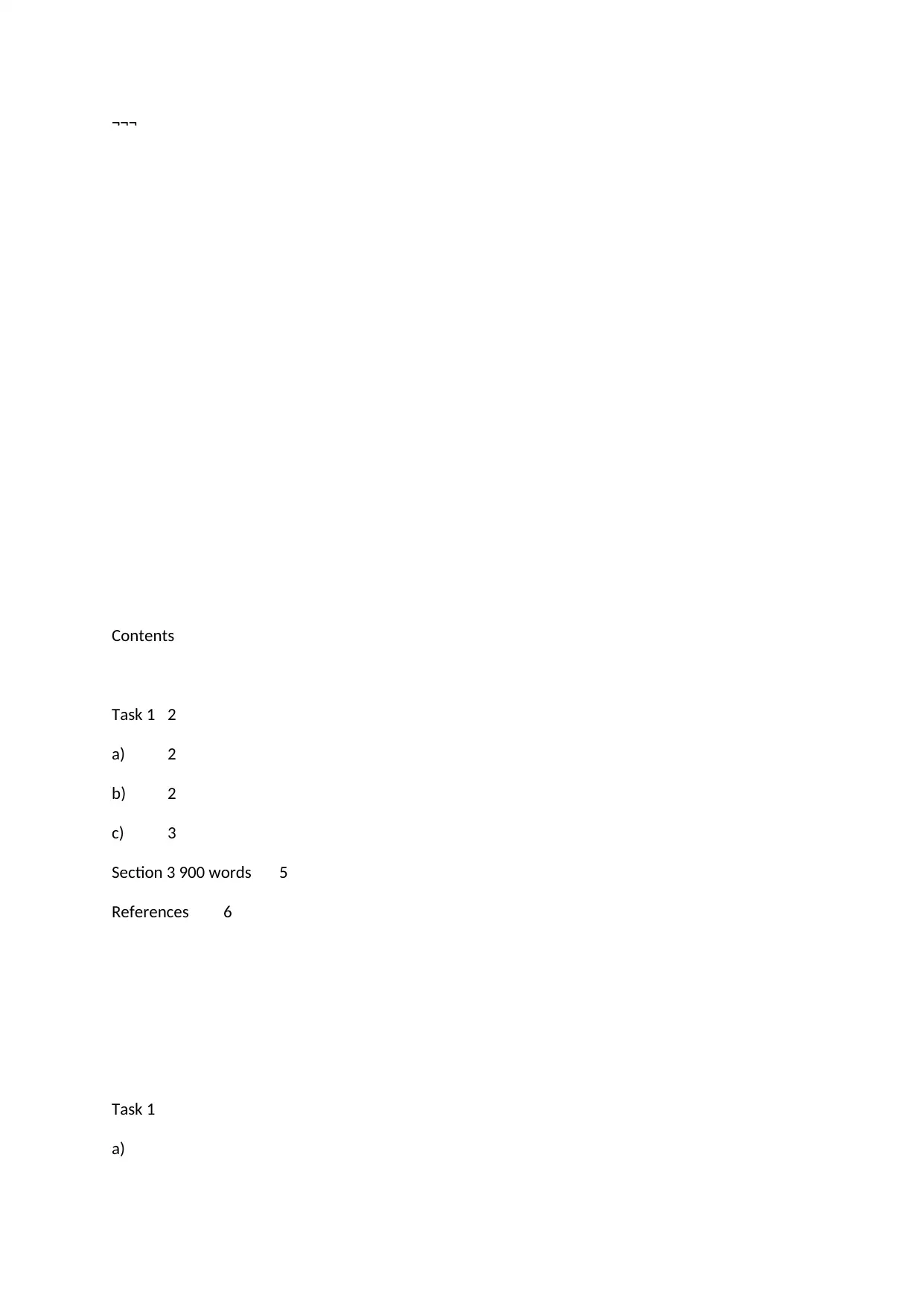
¬¬¬
Contents
Task 1 2
a) 2
b) 2
c) 3
Section 3 900 words 5
References 6
Task 1
a)
Contents
Task 1 2
a) 2
b) 2
c) 3
Section 3 900 words 5
References 6
Task 1
a)
Paraphrase This Document
Need a fresh take? Get an instant paraphrase of this document with our AI Paraphraser
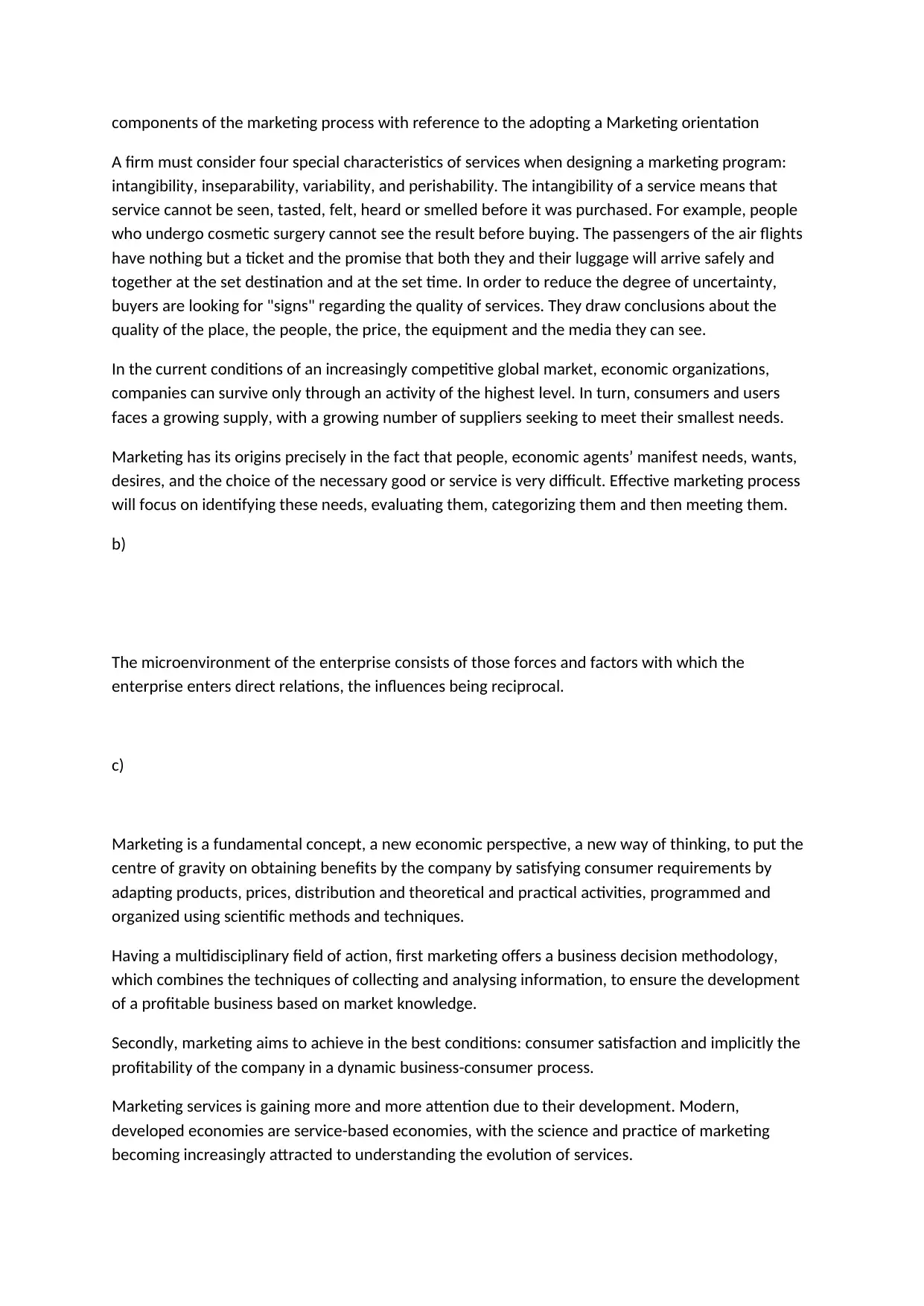
components of the marketing process with reference to the adopting a Marketing orientation
A firm must consider four special characteristics of services when designing a marketing program:
intangibility, inseparability, variability, and perishability. The intangibility of a service means that
service cannot be seen, tasted, felt, heard or smelled before it was purchased. For example, people
who undergo cosmetic surgery cannot see the result before buying. The passengers of the air flights
have nothing but a ticket and the promise that both they and their luggage will arrive safely and
together at the set destination and at the set time. In order to reduce the degree of uncertainty,
buyers are looking for "signs" regarding the quality of services. They draw conclusions about the
quality of the place, the people, the price, the equipment and the media they can see.
In the current conditions of an increasingly competitive global market, economic organizations,
companies can survive only through an activity of the highest level. In turn, consumers and users
faces a growing supply, with a growing number of suppliers seeking to meet their smallest needs.
Marketing has its origins precisely in the fact that people, economic agents’ manifest needs, wants,
desires, and the choice of the necessary good or service is very difficult. Effective marketing process
will focus on identifying these needs, evaluating them, categorizing them and then meeting them.
b)
The microenvironment of the enterprise consists of those forces and factors with which the
enterprise enters direct relations, the influences being reciprocal.
c)
Marketing is a fundamental concept, a new economic perspective, a new way of thinking, to put the
centre of gravity on obtaining benefits by the company by satisfying consumer requirements by
adapting products, prices, distribution and theoretical and practical activities, programmed and
organized using scientific methods and techniques.
Having a multidisciplinary field of action, first marketing offers a business decision methodology,
which combines the techniques of collecting and analysing information, to ensure the development
of a profitable business based on market knowledge.
Secondly, marketing aims to achieve in the best conditions: consumer satisfaction and implicitly the
profitability of the company in a dynamic business-consumer process.
Marketing services is gaining more and more attention due to their development. Modern,
developed economies are service-based economies, with the science and practice of marketing
becoming increasingly attracted to understanding the evolution of services.
A firm must consider four special characteristics of services when designing a marketing program:
intangibility, inseparability, variability, and perishability. The intangibility of a service means that
service cannot be seen, tasted, felt, heard or smelled before it was purchased. For example, people
who undergo cosmetic surgery cannot see the result before buying. The passengers of the air flights
have nothing but a ticket and the promise that both they and their luggage will arrive safely and
together at the set destination and at the set time. In order to reduce the degree of uncertainty,
buyers are looking for "signs" regarding the quality of services. They draw conclusions about the
quality of the place, the people, the price, the equipment and the media they can see.
In the current conditions of an increasingly competitive global market, economic organizations,
companies can survive only through an activity of the highest level. In turn, consumers and users
faces a growing supply, with a growing number of suppliers seeking to meet their smallest needs.
Marketing has its origins precisely in the fact that people, economic agents’ manifest needs, wants,
desires, and the choice of the necessary good or service is very difficult. Effective marketing process
will focus on identifying these needs, evaluating them, categorizing them and then meeting them.
b)
The microenvironment of the enterprise consists of those forces and factors with which the
enterprise enters direct relations, the influences being reciprocal.
c)
Marketing is a fundamental concept, a new economic perspective, a new way of thinking, to put the
centre of gravity on obtaining benefits by the company by satisfying consumer requirements by
adapting products, prices, distribution and theoretical and practical activities, programmed and
organized using scientific methods and techniques.
Having a multidisciplinary field of action, first marketing offers a business decision methodology,
which combines the techniques of collecting and analysing information, to ensure the development
of a profitable business based on market knowledge.
Secondly, marketing aims to achieve in the best conditions: consumer satisfaction and implicitly the
profitability of the company in a dynamic business-consumer process.
Marketing services is gaining more and more attention due to their development. Modern,
developed economies are service-based economies, with the science and practice of marketing
becoming increasingly attracted to understanding the evolution of services.
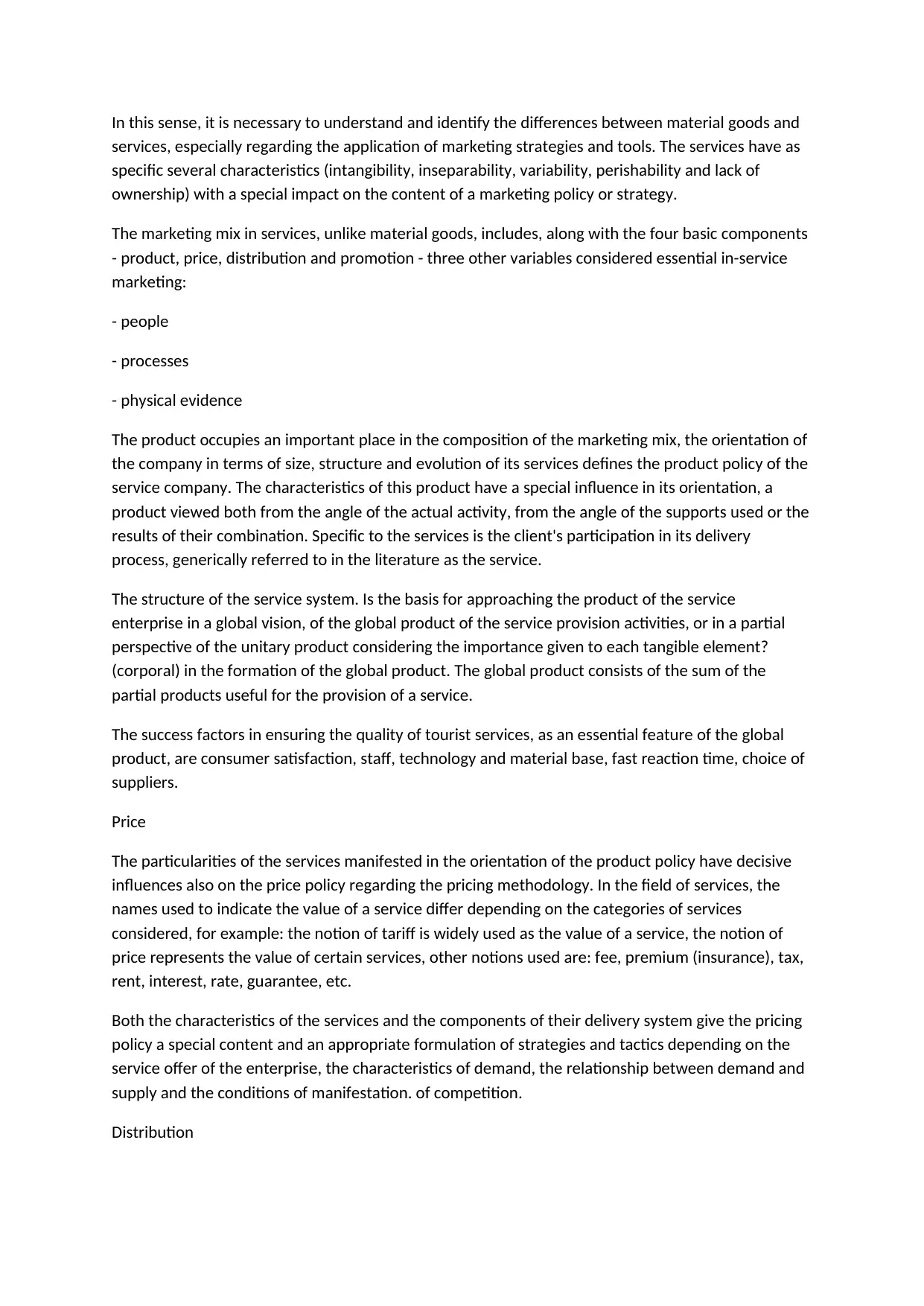
In this sense, it is necessary to understand and identify the differences between material goods and
services, especially regarding the application of marketing strategies and tools. The services have as
specific several characteristics (intangibility, inseparability, variability, perishability and lack of
ownership) with a special impact on the content of a marketing policy or strategy.
The marketing mix in services, unlike material goods, includes, along with the four basic components
- product, price, distribution and promotion - three other variables considered essential in-service
marketing:
- people
- processes
- physical evidence
The product occupies an important place in the composition of the marketing mix, the orientation of
the company in terms of size, structure and evolution of its services defines the product policy of the
service company. The characteristics of this product have a special influence in its orientation, a
product viewed both from the angle of the actual activity, from the angle of the supports used or the
results of their combination. Specific to the services is the client's participation in its delivery
process, generically referred to in the literature as the service.
The structure of the service system. Is the basis for approaching the product of the service
enterprise in a global vision, of the global product of the service provision activities, or in a partial
perspective of the unitary product considering the importance given to each tangible element?
(corporal) in the formation of the global product. The global product consists of the sum of the
partial products useful for the provision of a service.
The success factors in ensuring the quality of tourist services, as an essential feature of the global
product, are consumer satisfaction, staff, technology and material base, fast reaction time, choice of
suppliers.
Price
The particularities of the services manifested in the orientation of the product policy have decisive
influences also on the price policy regarding the pricing methodology. In the field of services, the
names used to indicate the value of a service differ depending on the categories of services
considered, for example: the notion of tariff is widely used as the value of a service, the notion of
price represents the value of certain services, other notions used are: fee, premium (insurance), tax,
rent, interest, rate, guarantee, etc.
Both the characteristics of the services and the components of their delivery system give the pricing
policy a special content and an appropriate formulation of strategies and tactics depending on the
service offer of the enterprise, the characteristics of demand, the relationship between demand and
supply and the conditions of manifestation. of competition.
Distribution
services, especially regarding the application of marketing strategies and tools. The services have as
specific several characteristics (intangibility, inseparability, variability, perishability and lack of
ownership) with a special impact on the content of a marketing policy or strategy.
The marketing mix in services, unlike material goods, includes, along with the four basic components
- product, price, distribution and promotion - three other variables considered essential in-service
marketing:
- people
- processes
- physical evidence
The product occupies an important place in the composition of the marketing mix, the orientation of
the company in terms of size, structure and evolution of its services defines the product policy of the
service company. The characteristics of this product have a special influence in its orientation, a
product viewed both from the angle of the actual activity, from the angle of the supports used or the
results of their combination. Specific to the services is the client's participation in its delivery
process, generically referred to in the literature as the service.
The structure of the service system. Is the basis for approaching the product of the service
enterprise in a global vision, of the global product of the service provision activities, or in a partial
perspective of the unitary product considering the importance given to each tangible element?
(corporal) in the formation of the global product. The global product consists of the sum of the
partial products useful for the provision of a service.
The success factors in ensuring the quality of tourist services, as an essential feature of the global
product, are consumer satisfaction, staff, technology and material base, fast reaction time, choice of
suppliers.
Price
The particularities of the services manifested in the orientation of the product policy have decisive
influences also on the price policy regarding the pricing methodology. In the field of services, the
names used to indicate the value of a service differ depending on the categories of services
considered, for example: the notion of tariff is widely used as the value of a service, the notion of
price represents the value of certain services, other notions used are: fee, premium (insurance), tax,
rent, interest, rate, guarantee, etc.
Both the characteristics of the services and the components of their delivery system give the pricing
policy a special content and an appropriate formulation of strategies and tactics depending on the
service offer of the enterprise, the characteristics of demand, the relationship between demand and
supply and the conditions of manifestation. of competition.
Distribution
⊘ This is a preview!⊘
Do you want full access?
Subscribe today to unlock all pages.

Trusted by 1+ million students worldwide
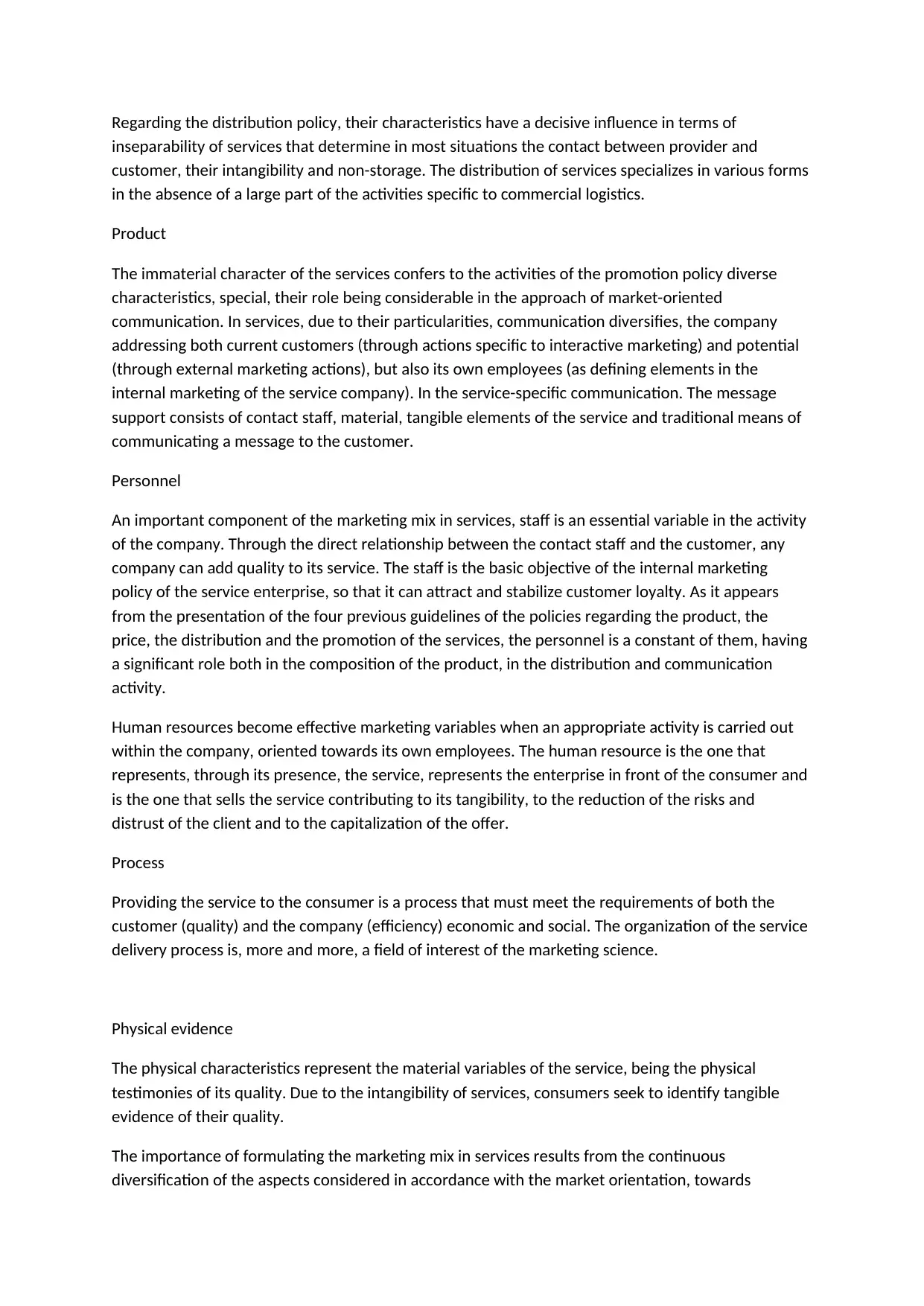
Regarding the distribution policy, their characteristics have a decisive influence in terms of
inseparability of services that determine in most situations the contact between provider and
customer, their intangibility and non-storage. The distribution of services specializes in various forms
in the absence of a large part of the activities specific to commercial logistics.
Product
The immaterial character of the services confers to the activities of the promotion policy diverse
characteristics, special, their role being considerable in the approach of market-oriented
communication. In services, due to their particularities, communication diversifies, the company
addressing both current customers (through actions specific to interactive marketing) and potential
(through external marketing actions), but also its own employees (as defining elements in the
internal marketing of the service company). In the service-specific communication. The message
support consists of contact staff, material, tangible elements of the service and traditional means of
communicating a message to the customer.
Personnel
An important component of the marketing mix in services, staff is an essential variable in the activity
of the company. Through the direct relationship between the contact staff and the customer, any
company can add quality to its service. The staff is the basic objective of the internal marketing
policy of the service enterprise, so that it can attract and stabilize customer loyalty. As it appears
from the presentation of the four previous guidelines of the policies regarding the product, the
price, the distribution and the promotion of the services, the personnel is a constant of them, having
a significant role both in the composition of the product, in the distribution and communication
activity.
Human resources become effective marketing variables when an appropriate activity is carried out
within the company, oriented towards its own employees. The human resource is the one that
represents, through its presence, the service, represents the enterprise in front of the consumer and
is the one that sells the service contributing to its tangibility, to the reduction of the risks and
distrust of the client and to the capitalization of the offer.
Process
Providing the service to the consumer is a process that must meet the requirements of both the
customer (quality) and the company (efficiency) economic and social. The organization of the service
delivery process is, more and more, a field of interest of the marketing science.
Physical evidence
The physical characteristics represent the material variables of the service, being the physical
testimonies of its quality. Due to the intangibility of services, consumers seek to identify tangible
evidence of their quality.
The importance of formulating the marketing mix in services results from the continuous
diversification of the aspects considered in accordance with the market orientation, towards
inseparability of services that determine in most situations the contact between provider and
customer, their intangibility and non-storage. The distribution of services specializes in various forms
in the absence of a large part of the activities specific to commercial logistics.
Product
The immaterial character of the services confers to the activities of the promotion policy diverse
characteristics, special, their role being considerable in the approach of market-oriented
communication. In services, due to their particularities, communication diversifies, the company
addressing both current customers (through actions specific to interactive marketing) and potential
(through external marketing actions), but also its own employees (as defining elements in the
internal marketing of the service company). In the service-specific communication. The message
support consists of contact staff, material, tangible elements of the service and traditional means of
communicating a message to the customer.
Personnel
An important component of the marketing mix in services, staff is an essential variable in the activity
of the company. Through the direct relationship between the contact staff and the customer, any
company can add quality to its service. The staff is the basic objective of the internal marketing
policy of the service enterprise, so that it can attract and stabilize customer loyalty. As it appears
from the presentation of the four previous guidelines of the policies regarding the product, the
price, the distribution and the promotion of the services, the personnel is a constant of them, having
a significant role both in the composition of the product, in the distribution and communication
activity.
Human resources become effective marketing variables when an appropriate activity is carried out
within the company, oriented towards its own employees. The human resource is the one that
represents, through its presence, the service, represents the enterprise in front of the consumer and
is the one that sells the service contributing to its tangibility, to the reduction of the risks and
distrust of the client and to the capitalization of the offer.
Process
Providing the service to the consumer is a process that must meet the requirements of both the
customer (quality) and the company (efficiency) economic and social. The organization of the service
delivery process is, more and more, a field of interest of the marketing science.
Physical evidence
The physical characteristics represent the material variables of the service, being the physical
testimonies of its quality. Due to the intangibility of services, consumers seek to identify tangible
evidence of their quality.
The importance of formulating the marketing mix in services results from the continuous
diversification of the aspects considered in accordance with the market orientation, towards
Paraphrase This Document
Need a fresh take? Get an instant paraphrase of this document with our AI Paraphraser
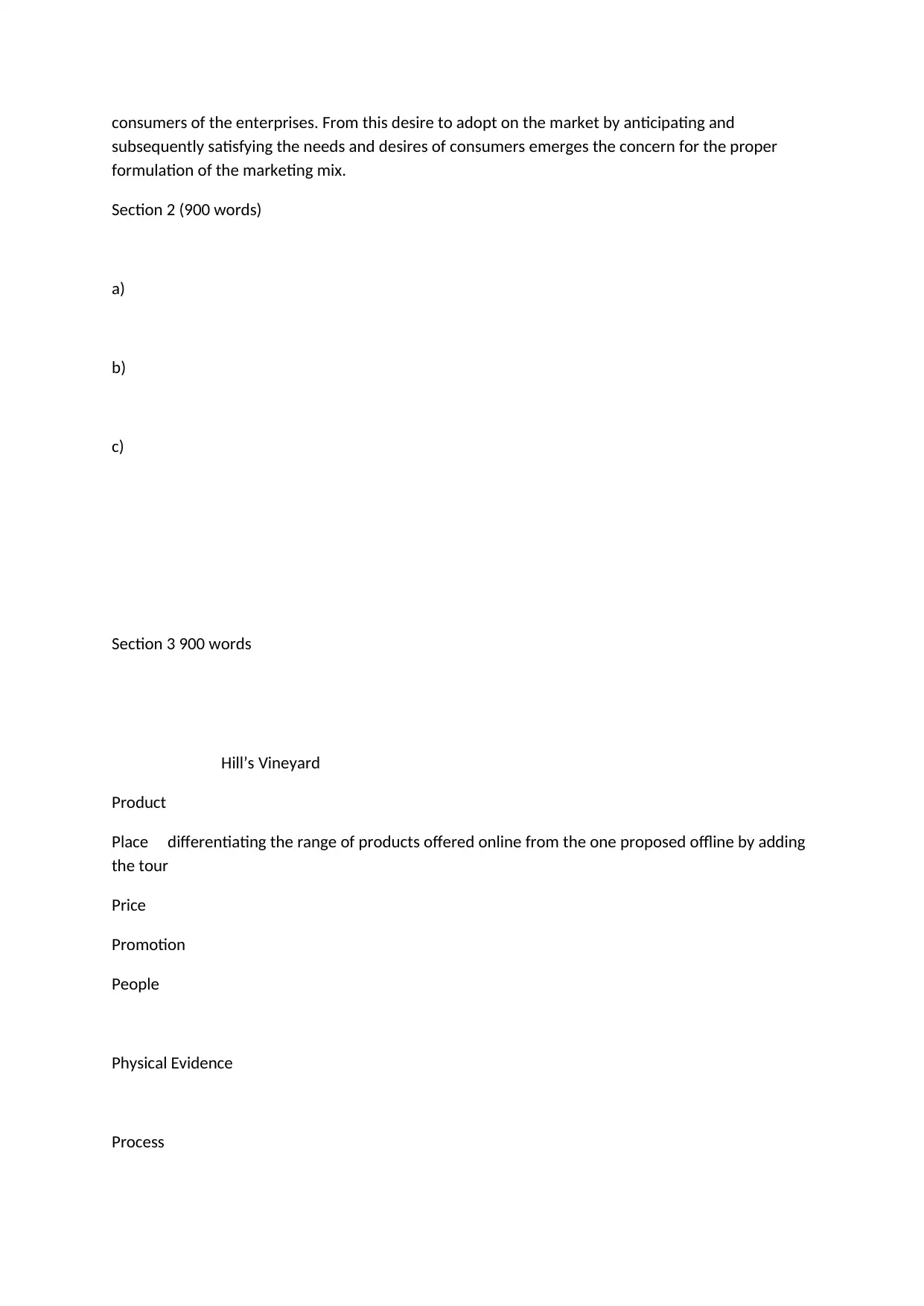
consumers of the enterprises. From this desire to adopt on the market by anticipating and
subsequently satisfying the needs and desires of consumers emerges the concern for the proper
formulation of the marketing mix.
Section 2 (900 words)
a)
b)
c)
Section 3 900 words
Hill’s Vineyard
Product
Place differentiating the range of products offered online from the one proposed offline by adding
the tour
Price
Promotion
People
Physical Evidence
Process
subsequently satisfying the needs and desires of consumers emerges the concern for the proper
formulation of the marketing mix.
Section 2 (900 words)
a)
b)
c)
Section 3 900 words
Hill’s Vineyard
Product
Place differentiating the range of products offered online from the one proposed offline by adding
the tour
Price
Promotion
People
Physical Evidence
Process
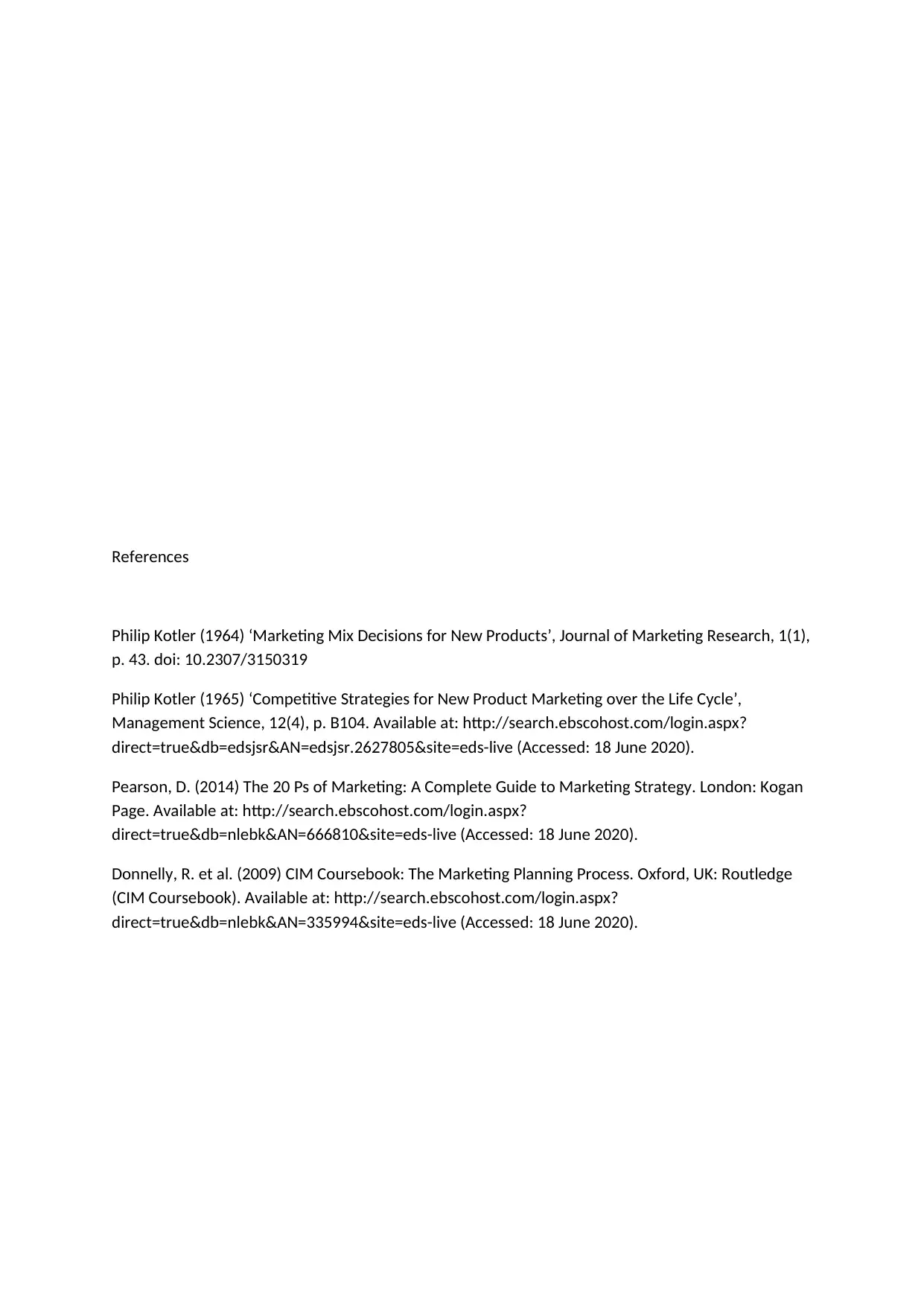
References
Philip Kotler (1964) ‘Marketing Mix Decisions for New Products’, Journal of Marketing Research, 1(1),
p. 43. doi: 10.2307/3150319
Philip Kotler (1965) ‘Competitive Strategies for New Product Marketing over the Life Cycle’,
Management Science, 12(4), p. B104. Available at: http://search.ebscohost.com/login.aspx?
direct=true&db=edsjsr&AN=edsjsr.2627805&site=eds-live (Accessed: 18 June 2020).
Pearson, D. (2014) The 20 Ps of Marketing: A Complete Guide to Marketing Strategy. London: Kogan
Page. Available at: http://search.ebscohost.com/login.aspx?
direct=true&db=nlebk&AN=666810&site=eds-live (Accessed: 18 June 2020).
Donnelly, R. et al. (2009) CIM Coursebook: The Marketing Planning Process. Oxford, UK: Routledge
(CIM Coursebook). Available at: http://search.ebscohost.com/login.aspx?
direct=true&db=nlebk&AN=335994&site=eds-live (Accessed: 18 June 2020).
Philip Kotler (1964) ‘Marketing Mix Decisions for New Products’, Journal of Marketing Research, 1(1),
p. 43. doi: 10.2307/3150319
Philip Kotler (1965) ‘Competitive Strategies for New Product Marketing over the Life Cycle’,
Management Science, 12(4), p. B104. Available at: http://search.ebscohost.com/login.aspx?
direct=true&db=edsjsr&AN=edsjsr.2627805&site=eds-live (Accessed: 18 June 2020).
Pearson, D. (2014) The 20 Ps of Marketing: A Complete Guide to Marketing Strategy. London: Kogan
Page. Available at: http://search.ebscohost.com/login.aspx?
direct=true&db=nlebk&AN=666810&site=eds-live (Accessed: 18 June 2020).
Donnelly, R. et al. (2009) CIM Coursebook: The Marketing Planning Process. Oxford, UK: Routledge
(CIM Coursebook). Available at: http://search.ebscohost.com/login.aspx?
direct=true&db=nlebk&AN=335994&site=eds-live (Accessed: 18 June 2020).
⊘ This is a preview!⊘
Do you want full access?
Subscribe today to unlock all pages.

Trusted by 1+ million students worldwide
1 out of 6
Related Documents
Your All-in-One AI-Powered Toolkit for Academic Success.
+13062052269
info@desklib.com
Available 24*7 on WhatsApp / Email
![[object Object]](/_next/static/media/star-bottom.7253800d.svg)
Unlock your academic potential
Copyright © 2020–2025 A2Z Services. All Rights Reserved. Developed and managed by ZUCOL.





